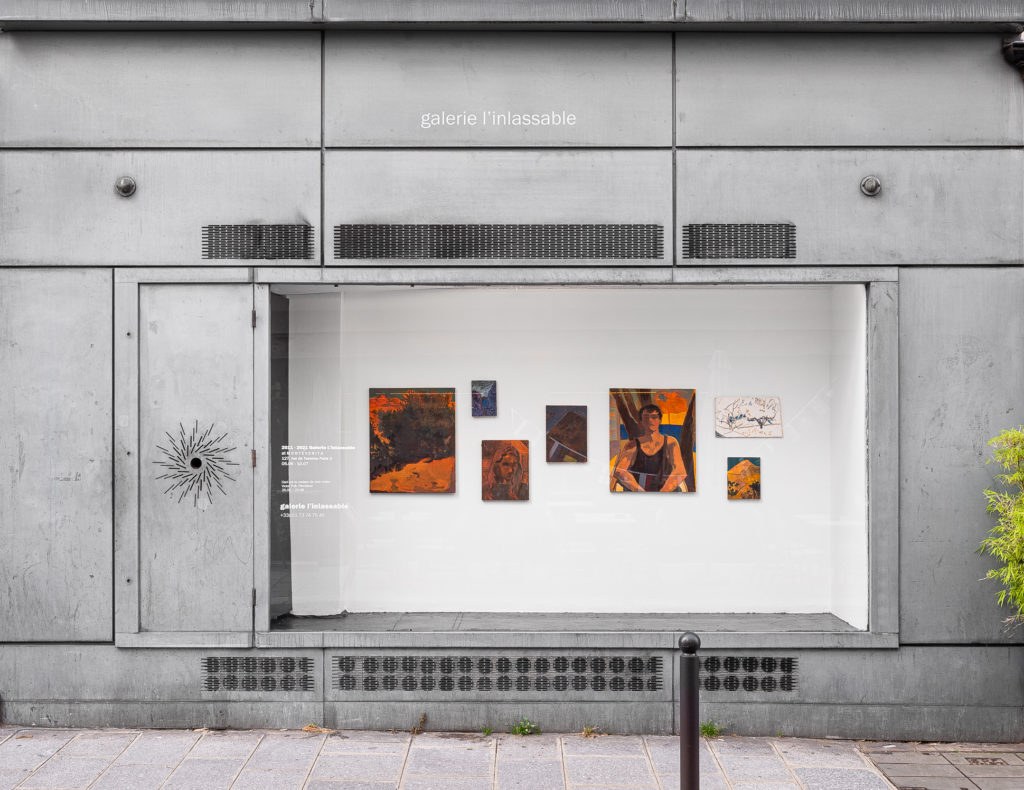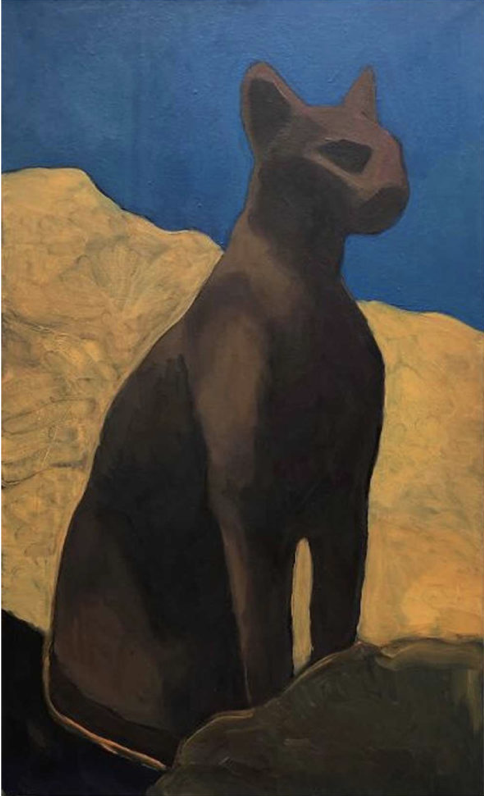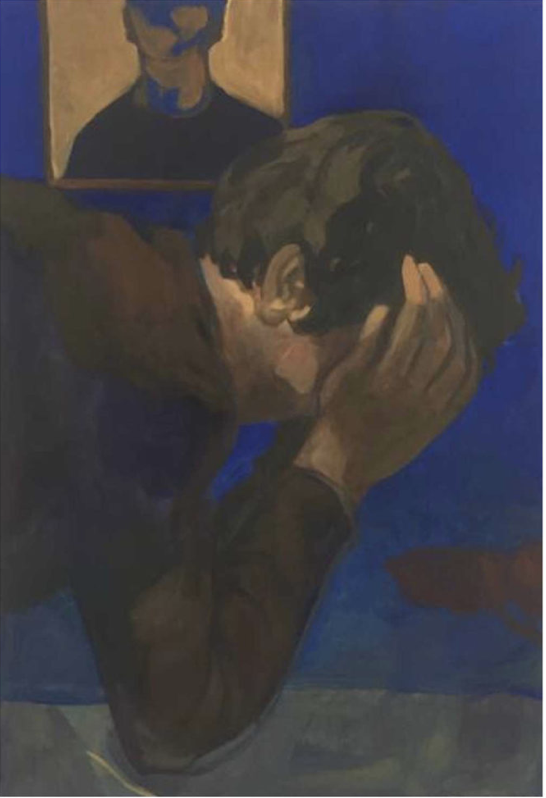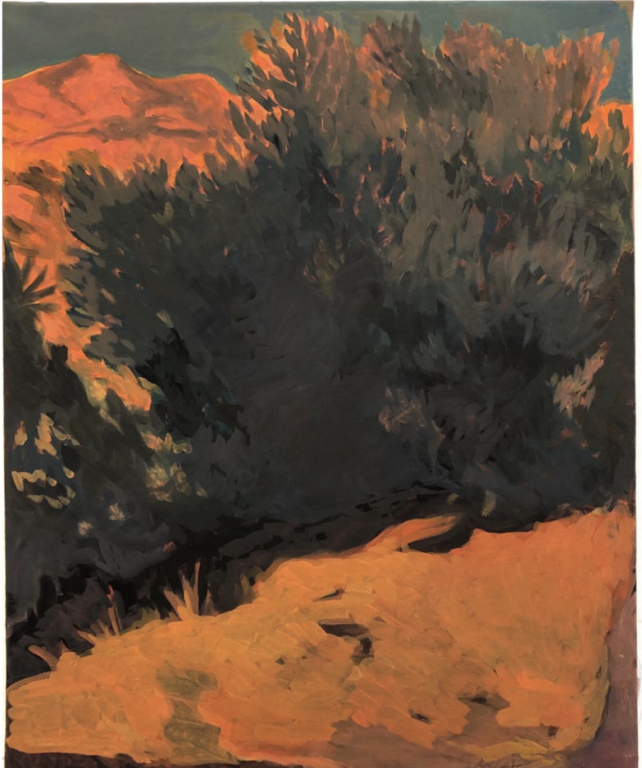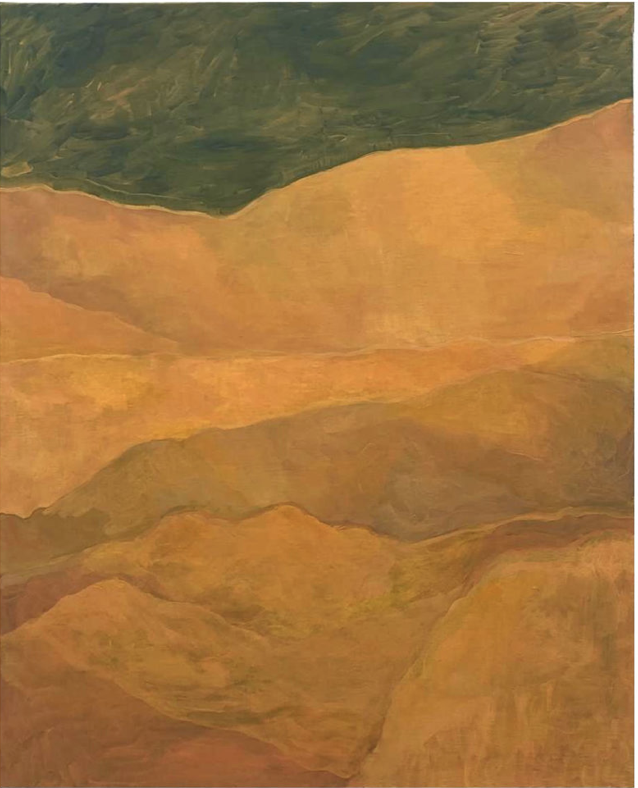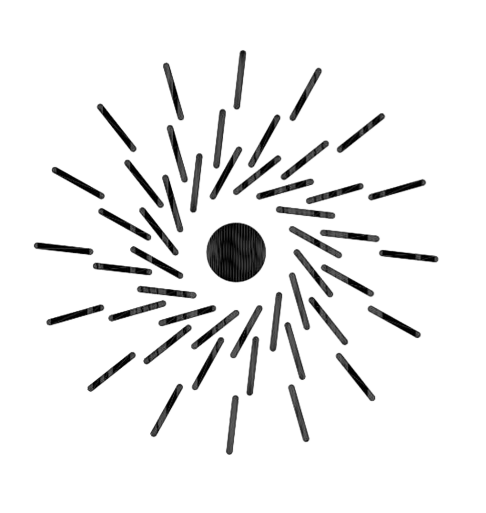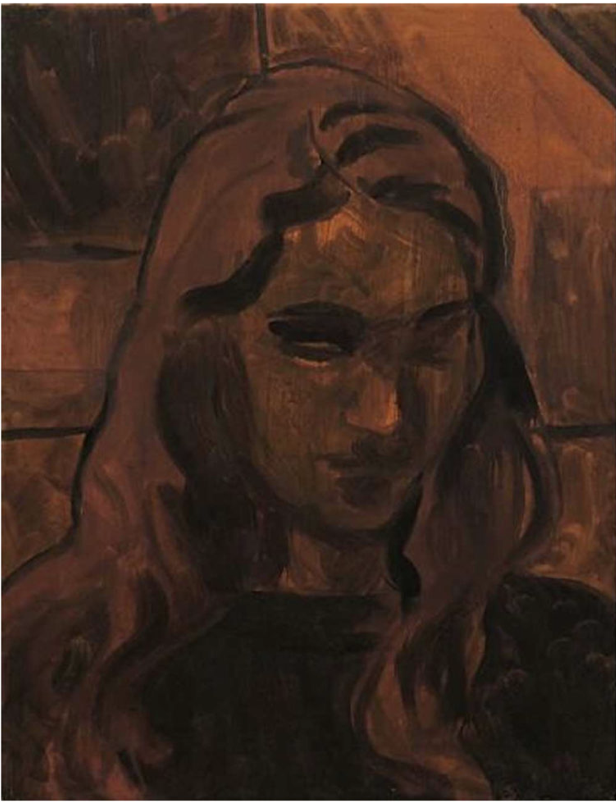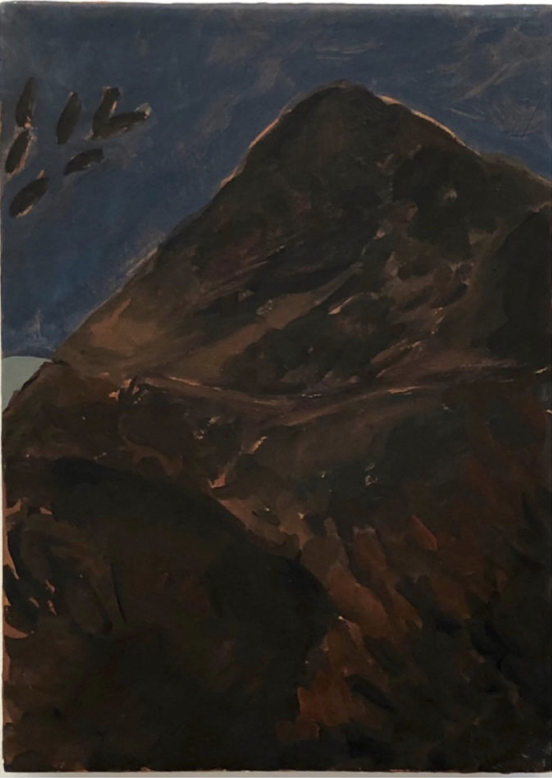During his first year of study in humanities, Victor Puš-Perchaud decides to devote himself to his dream: to become an artist. He joined the Ecole Supérieure des Beaux-Arts de Paris, and drawing and painting quickly became his main activities, although he also practices manga. He works on painting in François Boisrond’s studio and on manga with Joann Sfar.
« Painting is the choice for me to give my feeling of the world a chance to blossom and
to blossom and to be fixed in the matter. The pleasure, the softness, even the serenity are notions
that are dear to my heart. This pleasure is shaped by the work and by a presence in the world.
When I am in front of the walls of my studio, I use the photographic memories of my
I use the photographic memories of my cell phone as material and as a guide to paint. I use these lines from the world I inhabit to build the lines that, on my canvas, are emancipated by the colors and by the compositions that I imagine. It is a way for me to appropriate the world and to project my emotions
through color. The photographic image sometimes leaves the place to the memory and the imagination
alone. The gouaches that I paint are research on the motif and help me in the studio alongside
alongside digital images.
In my pictorial vocabulary, the self-portraits allow me a plastic setting in abyss of my feeling of the world and the of my feeling of the world and the matter of my face and my body are surfaces of experimentation
surfaces of experimentation and questioning. I question my relationship to the body, to the world
and identity, a multiple identity that is constructed through each canvas. I paint the color of my skin
I paint the color of my skin as if to ask the question of my origins. The self-portrait is also a rather direct way to testify of my present time and of my meditation of painter. The portraits are also the place of a projection, nuanced by the representation of an intimacy with others, and a space where the color and the lines can try to bloom in a pictorial balance.
Locked in the studio, the dialogue between the forms of the real and the re-imagination of this one through the color through color allows me to travel to the places I paint, to make them mine as in my series on in my series on Mount Minerva, inspired by Etel Adnan’s paintings on Mount Tamalpais. I have
sought with this series to travel to this landscape, to see it, to live it. The landscapes I paint are invested with landscapes I paint are invested with all my travels and are a way to see how an identity is constructed through a landscape, straddling several countries, through the blood, the lived or the
desires.
I try to paint a motif that is recognizable, but I want it to invade the surface of the canvas in
surface of the canvas in flat colors. In fact I am attached to representation and figuration. But the
photographic representation perspective does not suit me. I am attached to the drawing as much
as to the color. I would like to attribute to a figurative canvas, to each of its flat areas and to each of its
of its lines, the quality of an abstract canvas as Morandi would have done on the surface of his
Natura morta. I seek a form of painting which is also a current response to the history of this one, to its
history of this one, to its refusals then affirmations of the figuration or the abstraction, between
and affirmation of the artist’s hand. A painting which can in its form be relevant today.
I feel close, after the reading of the Wedding of Camus, of his thought of the absurd and of the beauty that persists in it, its colors, generous and austere. I also like the half-tones of Matisse, his « false notes » which make the painting move like a musical improvisation.
I like the notion of « failure » of the painting being done, and this unfinished state of the painting. I like the
painting as an image and matter, and its movement. I like to shift my gaze to observe the reflections of the light on the colors and the interactions of the matter on the chalk of which my canvas is coated. In this respect, I admire the painter Peter Doig and his work with matter, and the portraits of of Ada by the painter Alex Katz, his colors, and their false simplicity.
To paint is also to think. I mean to think, as Daniel Arasse explains it, with means of painting. I would like to be able to express a non-verbal thought. I am fascinated by the thoughts that some painters convey, similar to writers, emitting the same thought in each the same thought in each work, like a thread. To feel these meditations of the world gives me joy and pushes me to paint.
Finally, according to me, a painting is the present put into action. The present in its absurdity but a source of wonder, even of astonishment. It is of the being, a dead time in the multitude of the images and the sounds of the world. The goal of the painter is not always to finish his painting, what counts, to
painting, what counts, according to Antonio Lopez, in the film The dream of the light of Victor Erice, is to have « spent time » near the world painting. »
Victor Puš-Perchaud, 2021
*
Pendant sa première année d’études en sciences humaines, Victor Puš-Perchaud décide de se consacrer à son rêve : devenir artiste. Il intègre l’Ecole Supérieure des Beaux-Arts de Paris, et le dessin et la peinture deviennent rapidement ses activités principales, bien qu’il pratique également le manga. Il travaille la peinture dans l’atelier de François Boisrond et le manga avec Joann Sfar.
« Peindre, c’est le choix pour moi de donner sa chance à mon ressenti du monde de s’épanouir et de se fixer dans la matière. Le plaisir, la douceur, voire la sérénité sont des notions qui me tiennent à coeur. Ce plaisir est façonné par le travail et par une présence au monde.
Lorsque je suis face aux murs de mon atelier, j’utilise les souvenirs photographiques de mon portable comme matière et comme guide pour peindre. J’utilise ces lignes du monde que j’habite pour construire les lignes qui, sur ma toile, s’émancipent par les couleurs et par les compositions que j’imagine. C’est une manière pour moi de m’approprier le monde et d’y projeter mes émotions par la couleur. L’image photographique laisse parfois la place à la mémoire et à l’imagination seules. Les gouaches que je peins sont des recherches sur le motif et m’aident dans l’atelier aux côtés des images numériques.
Dans mon vocabulaire pictural, les auto-portraits me permettent une mise en abîme plastique de mon ressenti du monde et la matière de mon visage et de mon corps sont des surfaces d’expérimentation et de questionnement. J’y questionne mon rapport au corps, au monde et à l’identité, identité multiple qui se construit à travers chaque toile. Je peins la couleur de ma peau comme pour poser la question de mes origines. L’auto-portrait est aussi un moyen assez direct de témoigner de mon temps présent et de ma méditation de peintre. Les portraits sont également le lieu d’une projection, nuancée par la représentation d’une intimité avec autrui, et un espace ou la couleur et les lignes peuvent tenter de s’épanouir dans un équilibre pictural.
Enfermé dans l’atelier, le dialogue entre les formes du réel et la ré-imagination de celui-ci à travers la couleur me permet de voyager jusqu’aux lieux que je peins, de les faire miens comme dans ma série sur le Mont Minerve, inspiré par les toiles d’Etel Adnan sur le Mont Tamalpaïs. J’ai cherché avec cette série à voyager jusqu’à ce paysage, à le voir, à le vivre. Les paysages que je peins sont investis de tous mes voyages et sont un moyen de voir comment une identité se construit à travers un paysage, à cheval entre plusieurs pays, à travers le sang, le vécu ou les désirs.
Je cherche à peindre un motif qui soit reconnaissable, mais je veux qu’il envahisse la surface de la toile par aplats de couleurs. En fait je suis attaché à la représentation et à la figuration. Mais la représentation photographique perspective ne me convient pas. Je suis attaché au dessin autant qu’à la couleur. Je voudrais d’attribuer à une toile figurative, à chacun de ses aplats et à chacune de ses lignes, la qualité d’une toile abstraite comme Morandi l’aurait fait sur la surface de ses Natura morta. Je cherche une forme de peinture qui soit également une réponse actuelle à l’histoire de celle-ci, à ses refus puis affirmations de la figuration ou de l’abstraction, entre image générique numérique et affirmation de la main de l’artiste. Une peinture qui puisse dans sa forme être pertinente aujourd’hui.
Je me sens proche, après la lecture des Noces de Camus, de sa pensée de l’absurde et de la beauté qui y persiste, de ses couleurs, généreuses et austères. J’aime également les demi-tons de Matisse, ses « fausses notes » qui font se mouvoir la peinture telle une improvisation musicale. J’aime la notion d’« échec » de la peinture se faisant, et cet état inachevé de la peinture. J’aime la peinture en tant qu’image et matière, et son mouvement. J’aime décaler mon regard pour observer les reflets de la lumière sur les couleurs et les interactions de la matière sur la craie dont ma toile est enduite. J’admire à ce titre le peintre Peter Doig et son travail de la matière, et les portraits d’Ada du peintre Alex Katz, ses couleurs, et leur fausse simplicité. Peindre, c’est aussi penser. Je veux dire penser, comme l’explique Daniel Arasse, avec des moyens de peinture. Je voudrais arriver à exprimer une pensée non verbale. Je suis fasciné par les pensées que véhiculent certains peintres, semblables à des écrivains, émettant la même pensée à chaque oeuvre, comme un fil conducteur. Ressentir ces méditations du monde me donne de la joie et me pousse à peindre. Enfin selon moi, un tableau c’est du présent mis en oeuvre. Du présent dans son absurdité mais source d’émerveillement, voire d’étonnement. C’est de l’être, un temps mort dans la multitude des images et des sons du monde. Le but du peintre n’est d’ailleurs pas toujours de finir son
tableau, ce qui compte, d’après Antonio Lopez, dans le film Le songe de la lumière de Victor Erice,
c’est d’avoir « passé du temps » près du monde à peindre. »
Victor Puš-Perchaud, 2021
